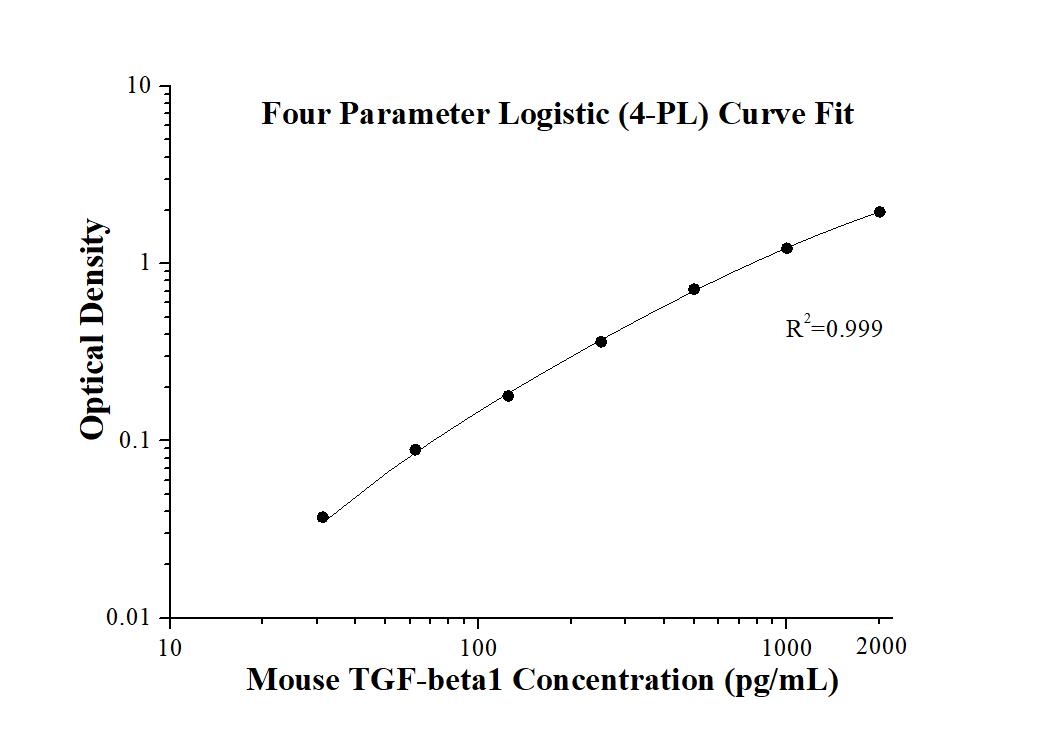Mouse TGF-beta1 ELISA Kit
Cat no : KE10005
Synonyms
TGF- beta 1, TGF beta1, Tgfb, Tgfb 1, Tgfb1, TGF-beta 1, TGFbeta1, TGF-beta1, TGF-beta-1, TGFβ1, TGF-β1
Validation Data Gallery
Product Information
KE10005 is a solid phase sandwich Enzyme Linked-Immuno-Sorbent Assay (Sandwich ELISA). The TGF-beta1 ELISA kit is to be used to detect and quantify protein levels of endogenous TGF-beta1. The assay recognizes mouse TGF-beta1. An antibody specific for TGF-beta1 has been pre-coated onto the microwells. The TGF-beta1 protein in samples is captured by the coated antibody after incubation. Following extensive washing, another antibody of biotinylated specific for TGF-beta1 is added to detect the captured TGF-beta1 protein. For signal development, Streptavidin-HRP is added, followed by Tetramethyl-benzidine (TMB) reagent. Solution containing sulfuric acid is used to stop color development and the color intensity which is proportional to the quantity of bound protein is measurable at 450 nm with the correction wavelength set at 630 nm. Note: This ELISA kit is cross-reactive with bovine, porcine, equine, and caprine. Therefore, the culture medium should not contain serum components associated with the above species.
| Product name | Mouse TGF-beta1 ELISA Kit |
| Tests | 1 X 96 well plate |
| Sample type | Serum, Plasma, Cell culture supernatants |
| Assay type | Sandwich |
| Sensitivity | 16.0 pg/mL |
| Range | 31.25-2000 pg/mL |
| Reactivity | Mouse |
| Tested applications | Sandwich ELISA |
| Gene ID (NCBI) | 21803 |
Recovery
| Sample Type | Average | Range |
|---|---|---|
| Mouse serum | 98% | 84%-115% |
| Cell culture supernatants | 91% | 80%-102% |
IntraAssay
| Sample | n | mean ( pg/mL) | SD | CV% |
|---|---|---|---|---|
| 1 | 20 | 72.4 | 3.3 | 4.5 |
| 2 | 20 | 154.8 | 11.1 | 7.2 |
| 3 | 20 | 295.8 | 19.7 | 6.7 |
InterAssay
| Sample | n | mean ( pg/mL) | SD | CV% |
|---|---|---|---|---|
| 1 | 24 | 58.9 | 4.4 | 7.5 |
| 2 | 24 | 128.0 | 6.8 | 5.3 |
| 3 | 24 | 248.0 | 17.4 | 7.0 |
Background Information
TGF-beta is a member of the transforming growth factor beta (TGFB) family of cytokines, which are multifunctional peptides that regulate proliferation, differentiation, adhesion, migration, and other functions in many cell types. TGF-beta is produced by a number of cell types including regulatory T cells, fibroblasts, epithelial cells, and endothelial cells. TGF-beta acts synergistically with TGFA in inducing transformation. It also acts as a negative autocrine growth factor. TGF-beta plays an important role in bone remodeling as it is a potent stimulator of osteoblastic bone formation, causing chemotaxis, proliferation and differentiation in committed osteoblasts. Mice lacking TGF-beta develop severe multifocal inflammatory disease, yolk sac defects and colon cancer.
Properties
| Storage Instructions | All the reagents are stored at 2-8℃ for 6 months or -20℃ for 12 months. Refer to the protocol for further storage instructions. |
| Synonyms | TGF- beta 1, TGF beta1, Tgfb, Tgfb 1, Tgfb1, TGF-beta 1, TGFbeta1, TGF-beta1, TGF-beta-1, TGFβ1, TGF-β1 |
Publications
| Species | Sample Type | Title |
|---|---|---|
Cell Metab IgG is an aging factor that drives adipose tissue fibrosis and metabolic decline | ||
Nat Metab LIFR regulates cholesterol-driven bidirectional hepatocyte-neutrophil cross-talk to promote liver regeneration | ||
Biomaterials The programmed site-specific delivery of LY3200882 and PD-L1 siRNA boosts immunotherapy for triple-negative breast cancer by remodeling tumor microenvironment. | ||
Adv Healthc Mater Releasable, Immune-Instructive, Bioinspired Multilayer Coating Resists Implant-Induced Fibrosis while Accelerating Tissue Repair | ||
Acta Biomater Collagen patches releasing phosphatidylserine liposomes guide M1-to-M2 macrophage polarization and accelerate simultaneous bone and muscle healing | ||
Proc Natl Acad Sci U S A miR-182 targeting reprograms tumor-associated macrophages and limits breast cancer progression. |

